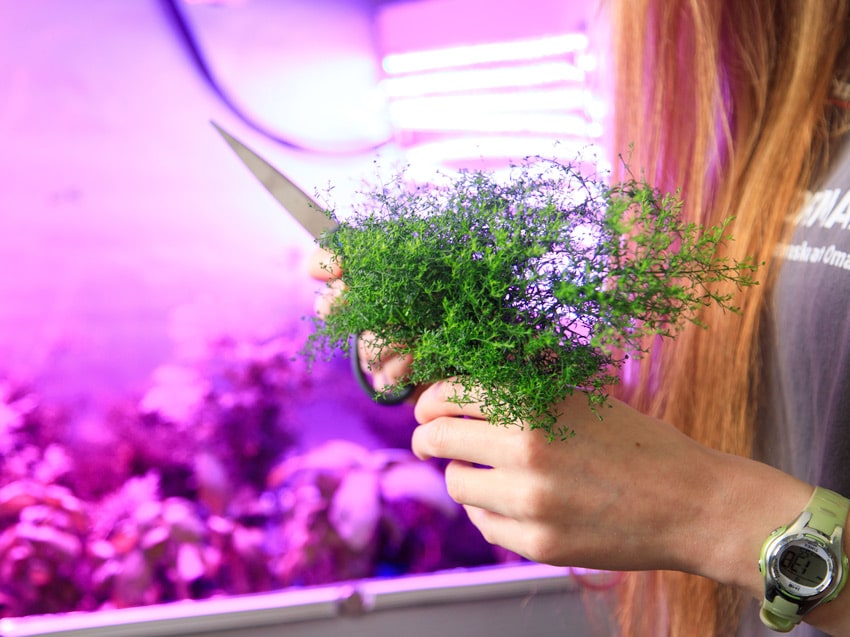Creating a Food Revolution with Indoor Farming
By Jackie Ostrowicki
March 2021
When you think of agriculture, do you think of technology? If not, you should. Innovative agriculture techniques play a vital role in the next generation of food production—which explores how technology can address important issues related to food.
One of those issues is disparities around access to healthy, fresh food—suffered disproportionately by many Black, Latinx and indigenous communities. Feeding America identified 237,440 Nebraskans as food insecure in 2018, about 12% of the population.
COVID-19 has only exacerbated food insecurity. The food insecurity rate in Nebraska has been estimated to rise 20% between 2019 and 2020 due to the pandemic. Equitable access to local, fresh, affordable food will be critical in helping to address hunger.

This is the kind of work being done by Kiran Bastola, a bioinformatics professor at UNO with a Ph.D. in plant biology—and the grandson of farmers in Nepal, where nearly 70% of the population is involved in agriculture. Bastola has created a food computer with multiple applications, from education to farming to developing better food-based plants. His work explores environmentally controlled agriculture, where computer programs can closely monitor and adjust different environmental factors to maximize the elements of a plant's biology—making food-based plants fresher, longer-lasting and better tasting.
The Personal Food Computer
Bastola‘s personal food computer can be used in the classroom, at home or in a small business. It is an enclosed plant growth chamber the size of a dorm-room refrigerator loaded with LEDs, sensors, pumps, fans, control electronics, and a hydroponic tray for growing plants.
The chamber is attached to a computer, and uses technology to adjust factors like light, air, humidity, water and temperature to create the ideal growing environment for the food being grown inside. Microgreens require a different environment than basil, for example, and the computer takes out any guesswork. It's a simple yet revolutionary idea: a portable box that can grow practically any kind of plant—just by downloading a recipe and planting some seeds.
Tech-assisted indoor farming could help combat food insecurity and food access disparity in underserved communities—whether that be in urban or rural areas. The real agricultural impact is the potential to grow crops indoors, which can feed more people using less land and water. And crops can grow year-round.
"The food computer addresses food insecurity by providing access to healthy food—and doing so on a continuous basis. When you grow food indoors, it's not affected by the seasons."
—Dr. Kiran Bastola
No green thumb is needed for users to grow plants that can then be consumed or sold. It supports both people who need access to food—and the people providing that food. In addition to feeding families, plants grown with the food computer can serve as a source of viable income, using cost-effective, innovative agricultural techniques—which creates an economic as well as a social benefit.
Science Education in K-12 Schools
Bastola's food computer has been used by graduate students in UNO's College of Information Science and Technology and elementary school students alike to better understand the concepts behind the food we eat.
"We need to be preparing young generations to understand and be interested in agriculture," Bastola said. "They may have an understanding of farming that is not complete. Many students may not want to go into traditional farming, but they may be interested in farming that features an IT component, such as technology-assisted farming."
Bastola has worked to bring technology like the food computer into classrooms in rural and urban areas across the region, especially those with high levels of food insecurity and fewer opportunities to learn STEM-based skills. The more that young people are engaged at an early age, the more likely they are to envision themselves addressing the pressing issues that will impact food production in the coming decades.
The more that young people are engaged at an early age, the more likely they are to envision themselves addressing the pressing issues that will impact food production in the coming decades.
The food computer is a way to make science, technology and even math come to life. Teachers can instruct students on carbon dioxide, and plant life cycles, photosynthesis and chlorophyll using real plants instead of a blackboard. And it creates an actual harvest—lettuce, basil, tomatoes and spicy microgreens that students eat and take home. This is food that many students have rarely eaten, but have now grown themselves.
Indoor Farming: The Food Source of the Future?
As the number of mouths that need to be fed across the world has grown, the idea of indoor farming is gaining traction. Indoor farming isn't land intensive. New technologies like Bastola's and advancements in hydroponics are making it possible to grow crops without pesticides, soil or even natural light. And indoor crops can be stacked vertically, making it environmentally sustainable.
Bastola hopes to turn his concept into a food revolution through education, continued research and entrepreneurship. He plans to continue working with community partners who combat food disparities and training young scientists in STEM skills that support agriculture in an urban environment. He would also like to increase the amount of indoor farming being done, especially when it comes to commercial production.
"My dream is for the food computer to not only help people who want to eat healthy but can't afford it—but to also serve as a source of income. I've seen people growing microgreens who make anywhere from $1,000 to $1,500 per week. That could make a tremendous economic difference," Bastola said. "And, at the end of the day, that's why I'm here. To make a difference."
Discover our Podcast Series
The “Leading Nebraska” podcast shares the stories of the researchers, students, teachers and others across the University of Nebraska's four campuses who are making an impact. From teachers and doctors to engineers and ag experts, these Nebraska leaders are touching lives and making a difference.